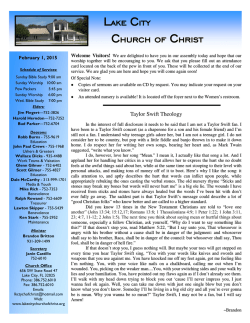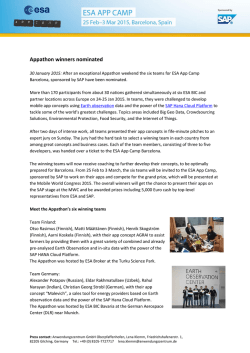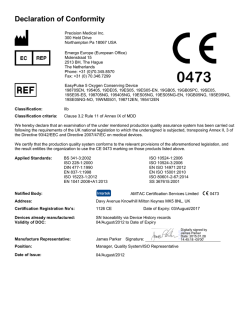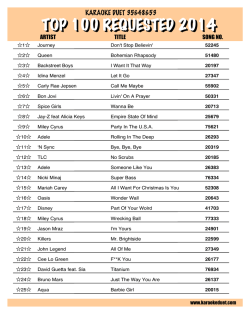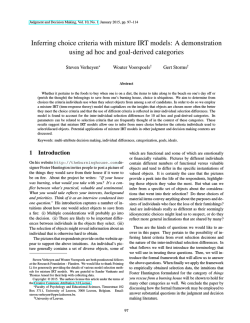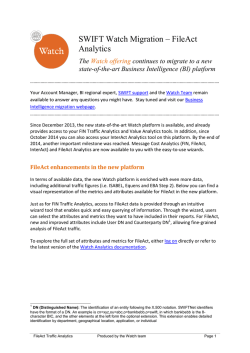
BIC Policy - SWIFT
SWIFT BIC Policy This document provides specific guidelines for the use of BICs by SWIFT users, in particular as identifiers and addresses within the SWIFT messaging services. 30 January 2015 Table of Contents Table of Contents Preface .................................................................................................................................................3 1 Entity Identifiers .......................................................................................................................4 1.1 1.2 2 Directory Publication ...............................................................................................................5 2.1 2.2 3 ISO 9362 Directory..................................................................................................................5 SWIFTRef Directories .............................................................................................................5 BIC Usage ..................................................................................................................................6 3.1 3.2 4 BIC and the ISO 9362 Standard .............................................................................................4 BIC Structure ...........................................................................................................................4 Network Address .....................................................................................................................6 Party Identifier within Messages or Files ................................................................................6 BIC Registration, Validation, Activation, and Deactivation .................................................7 4.1 4.2 4.3 4.4 Registration .............................................................................................................................7 Validation ................................................................................................................................7 Activation .................................................................................................................................7 Deactivation ............................................................................................................................7 Legal Notices ......................................................................................................................................9 30 January 2015 2 Preface Preface Purpose of this document This document provides specific guidelines for the use of BICs by SWIFT users, in particular as identifiers and addresses within the SWIFT messaging service. This BIC Policy is an integral part of the contractual arrangement between SWIFT and its customers. Other SWIFT documentation might also need to be updated. Until such other documentation is updated, and in case of any inconsistency between this policy and other SWIFT documentation, this policy prevails. Intended audience SWIFT intends this document for its customers. In particular, the following persons should read this document: · technical experts who operate the SWIFT service · business decision makers who deal with entity identification, risk management, and exposure management · legal, audit, and compliance officers · vendors who integrate BICs into services and applications Related documentation · SWIFT User Handbook – Corporate Rules (By-Laws) · SWIFT User Handbook – FIN Service Description · SWIFT User Handbook – SWIFTNet Service Description · SWIFT User Handbook – SWIFTNet Naming and Addressing Guide · ISO 9362:2014 Standard available at www.iso.org · BIC Registration Procedures available at www.swift.com/bic SWIFT-defined terms This document contains terms that have a specific meaning in the context of SWIFT documentation (for example, customer, user, or SWIFT services and products). The definitions of SWIFT-defined terms appear either in this document or in the SWIFT Glossary. In this document SWIFT differentiates these terms as shown in this example: SWIFT provides secure, standardised messaging services and interface software to its customers. Significant changes This update to the BIC Policy reflects the introduction of the revised version of the ISO 9362 Standard in 2014. In addition to the revised version of the ISO 9362 Standard, a new BIC Registration Procedures document has been developed to specify the roles and responsibilities of the different actors including the applicants and owners of BICs. The document is available at www.swift.com/bic The implementation of the revised edition of the ISO 9362 Standard will be phased. ISO has agreed to an exceptional transition period that starts in the first quarter of 2015 and ends in November 2018. During this transition period, there will be backwards compatibility. For more information, see the ISO 9362:2014 BIC Implementation White Paper available at www.swift.com/bic 30 January 2015 3 Entity Identifiers 1 Entity Identifiers 1.1 BIC and the ISO 9362 Standard The BIC is an established international standard defined in the ISO 9362 Standard document available at www.iso.org This ISO Standard specifies the elements and structure of a universal identifier code, the business identifier code (BIC), for financial and non-financial institutions that require an international identifier to facilitate automated processing of information for financial services. SWIFT is the designated ISO Registration Authority (RA) for the ISO 9362 Standard. BIC identifies organisations (excluding individuals). BICs are either valid or expired. 1.2 BIC Structure The BIC is an 8-character code consisting of the business party prefix (4 alphanumeric), the country code (2 alphabetic, specified in ISO 3166-1), and the business party suffix (2 alphanumeric). This 8-character BIC identifies the ‘Business Party’ and is also referred to as the ‘Business Party identifier’. The 8-character BIC can be supplemented with a 3-character optional element to identify an organisational unit of the Business Party such as a specific location, department, service of the Business Party in the country where the Business Party is located. This optional 3-character code (3 alphanumeric) identifies a ‘Branch’ of the Business Party and is also referred to as the ‘Branch identifier’. The Branch identifier belongs to the Business Party identified by the 8character BIC and, excluding a few existing legacy arrangements for co-operative banking groups, cannot be used to identify a separate legal entity or a third party. Example: For more information about the BIC structure, see the published ISO 9362 Standard at www.iso.org 30 January 2015 4 Directory Publication 2 Directory Publication 2.1 ISO 9362 Directory As part of its Registration Authority (RA) function, SWIFT publishes BICs and related data records (that contain the ISO 9362 reference data attributes for each BIC) in the ISO 9362 Directory on www.swift.com/bic Under normal circumstances, BICs and related BIC data records will be published in the ISO 9362 Directory within one business day after successful validation of the information supporting the request. For more information about the BIC publication procedure and the roles and responsibilities of the applicants and Registration Authority with respect to the BIC, see the BIC Registration Procedures document available at www.swift.com/bic 2.2 SWIFTRef Directories SWIFTRef refers to SWIFT’s unique reference data service. SWIFT manages a portfolio of SWIFTRef directories. The BIC Directory is part of this portfolio. SWIFT recommends customers to use the SWIFTRef directories to obtain additional SWIFTspecific information for the usage of BICs on the SWIFT messaging services. For a complete list of SWIFTRef products and services, see www.swift.com/SWIFTRef 30 January 2015 5 BIC Usage 3 BIC Usage On the SWIFT messaging services, the BIC can be used as network address and/or as a party identifier. As a general principle, users are responsible for all messages sent or other operations performed under their BIC(s). 3.1 Network Address On the SWIFT messaging services, the BIC is used as network address to identify the sender and receiver of a message or a file. Each user of SWIFT messaging services must have at least one valid connected 8-character BIC. Users of the FIN service must publish at least one valid connected 8-character BIC. FIN users who decide to use, in addition to their published 8-character BIC, non-published BICs must ensure the use of any such non-published BIC is duly covered by a bilateral or, as the case may be, multilateral agreement between all parties concerned. An 8-character BIC with ‘1’ in the eighth position cannot be used as connected BIC to send or receive messages or files over SWIFT. For more information about the use of BICs as network address on the SWIFT messaging services, see the relevant service documentation. 3.2 Party Identifier within Messages or Files BICs can also be used by users to identify a party within the message or the file sent through SWIFT messaging services. Unlike network addresses that require a connected BIC, users can use either a connected or non-connected BIC as party identifier within a message or a file. In all cases, the BIC used to identify a party within the message or the file must be a valid BIC and, in the case of the FIN service, it must also be a published BIC. Where permitted, users who decide to also use a nonpublished BIC to identify a party in a message or file must ensure the use of any such nonpublished BIC is duly covered by bilateral or, as the case may be, multilateral agreements between all parties concerned. For more information about the use of BICs to identify a party within the message or the file on the SWIFT messaging services, see the relevant service documentation. 30 January 2015 6 Registering and Maintaining a BIC 4 BIC Registration, Validation, Activation, and Deactivation The then current version of the ISO 9362 Standard (available at www.iso.org) and of the BIC Registration Procedures (available at www.swift.com/bic) govern the registration of BICs and the related roles and responsibilities of all parties involved. Customers must comply with all obligations applicable to them under that documentation and this Policy. Failure to do so may result into the expiry of the affected BICs. It may also cause SWIFT to suspend or terminate the SWIFT usership and/or the provision of SWIFT services and products. Without prejudice to the generality of the foregoing, customers are reminded that, until the expiry of the BIC, they remain ultimately responsible for the correctness, update, and completeness of the data record of their BIC(s). This applies equally in case of a third-party registration at least as long as the third party for which the customer may have requested a BIC does not officially confirm to the Registration Authority that it takes over the responsibility for its BIC. Customers can also find more information about how to register, maintain, or expire BICs at www.swift.com/ordering 4.1 Registration Users can register one or more BICs for their own organisation (self-registration). To identify a third party and facilitate automated processing of telecommunication messages in banking and related financial transaction environments, users can also register a BIC for a third party (third-party registration). In case of a third-party registration, the requesting user must inform the third party for which the BIC is registered. A non-connected BIC must always be published. A connected BIC is allocated to a duly registered SWIFT user and after successful validation of the subscription to SWIFT messaging services only. 4.2 Validation BIC registration requests are validated by SWIFT as the Registration Authority. Users are strongly advised to submit registration requests and to provide all necessary information and documents well in advance to allow sufficient time for such validation. For more information about typical validation lead times, see SWIFT’s ordering site at www.swift.com/ordering or contact your SWIFT commercial manager. 4.3 Activation As a general rule, SWIFT activates BICs on SWIFT messaging services on a Saturday. A new FIN connected BIC is published upon activation only. Users subscribing to the FIN service who already have a non-connected BIC must request the expiry of that non-connected BIC. The non-connected BIC will expire within the month following the activation in the live environment. 4.4 Deactivation As a general rule, SWIFT deactivates BICs on SWIFT messaging services on the first Saturday of the month. If a user exceptionally requests the deactivation of a published BIC to take place on another date, the user must advise the user community of the deactivation of its BIC by means of a SWIFT broadcast message. 30 January 2015 7 Registering and Maintaining a BIC Users of the FIN service who request the deactivation of a connected BIC in the live environment must also request the expiry of that BIC at the same time. Once deactivated and expired, the BIC can no longer serve to send or to receive messages or files on the SWIFT messaging services or to identify a party in a message or file. 30 January 2015 8 Legal Notices Legal Notices Copyright SWIFT © 2015. All rights reserved. Disclaimer The information in this publication may change from time to time. You must always refer to the latest available version. Translations The English version of SWIFT documentation is the only official and binding version. Trademarks SWIFT is the trade name of S.W.I.F.T. SCRL. The following are registered trademarks of SWIFT: the SWIFT logo, SWIFT, SWIFTNet, Accord, Sibos, 3SKey, Innotribe, the Standards Forum logo, MyStandards, and SWIFT Institute. Other product, service, or company names in this publication are trade names, trademarks, or registered trademarks of their respective owners. 30 January 2015 9
© Copyright 2026
